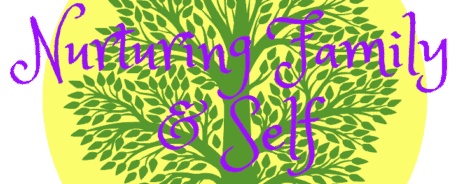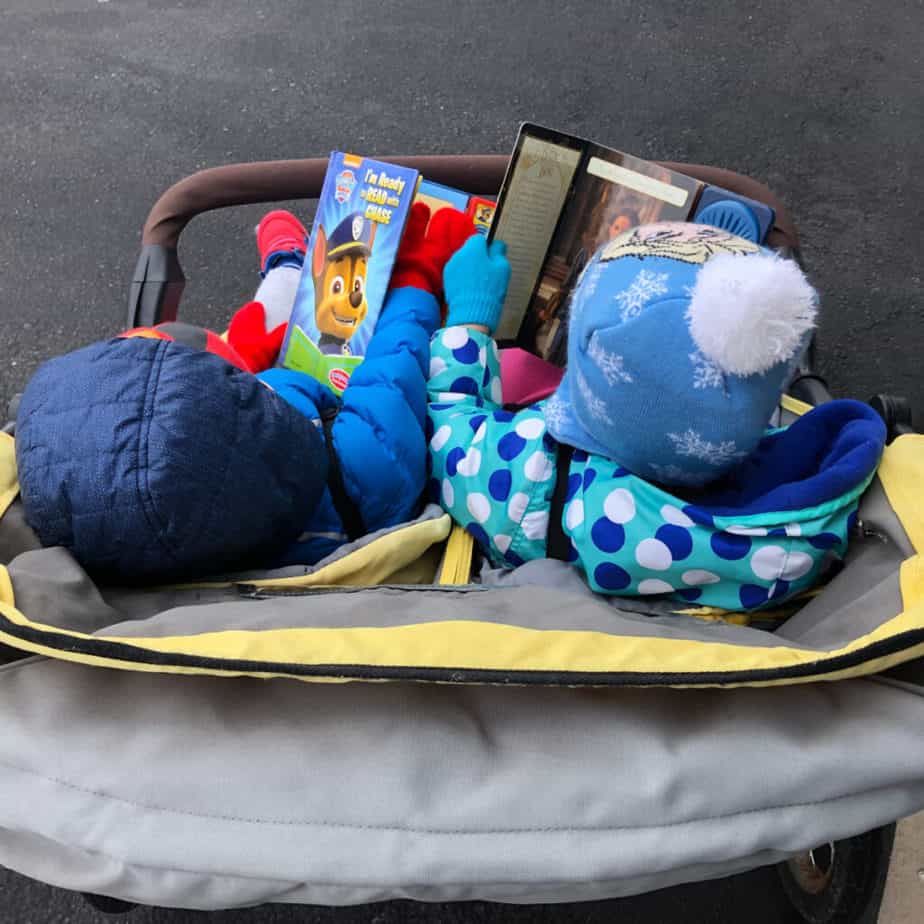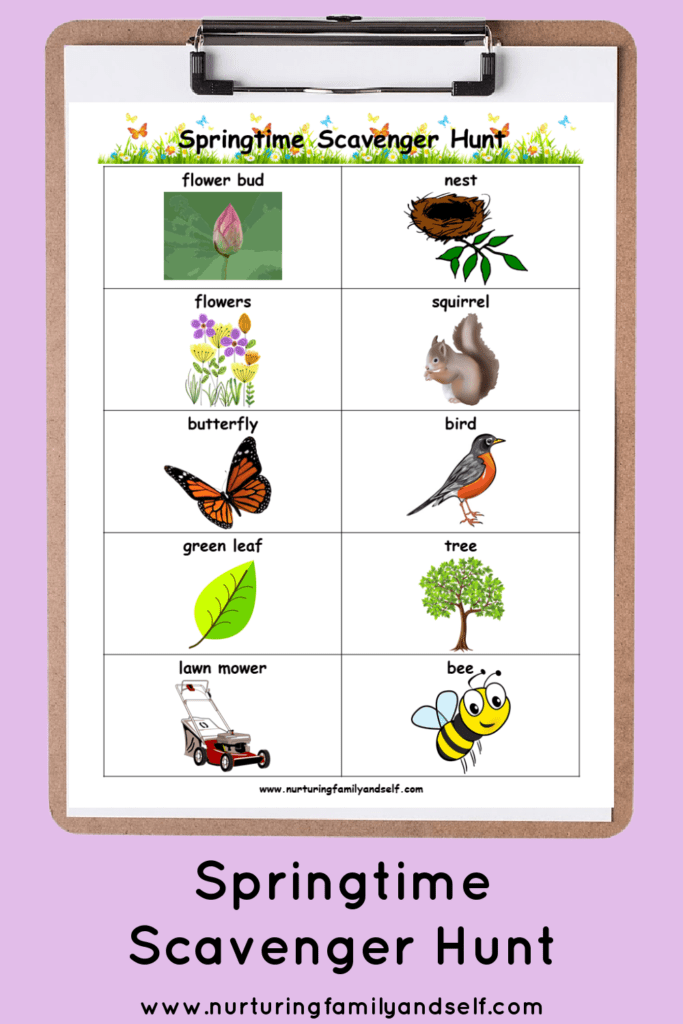This post may contain affiliate links. If you choose to make a purchase through these links, I earn a small commission at no cost to you. I do not promote anything I do not believe in or stand behind.
Daily walks is a must do activity for me. It has been an essential part of our daily routine since the newborn days. Not only does it help me reach my goal of 10,000 steps, it is a wonderful way to spend time together outside with my little ones.
The exercise and fresh air a walk provides is great for my overall health. I choose to push my 2 year old and 4 ½ year old in a double jogging stroller. But my 4 ½ year old is not the most content in a stroller. Now I know I could let her use a scooter, ride a bike or walk, but she does not enjoy these activities either. So I use the stroller and it makes for a great workout, especially when walking uphill.
Walking with my kids, well my 4 ½ year old, requires a lot of effort on my end. I’m constantly finding ways to engage her during our walk.
I am well aware that I could give her a tablet to watch something during our walk, but I would rather use the time when she is strapped in the stroller to engage in fun learning games and activities. Plus, it gives my kids an opportunity to learn about their neighborhood when they are actively looking for specific things and taking notice to all the sights and sounds.
There is a time and place for using a tablet and we let our daughter watch things on a longer car ride, but choose not to use it for daily walks. This is what my husband and I decided upon, but you must decide what works best for your family.
My 2 year old is perfectly content in the stroller. In fact, when I take him out for a solo walk, we usually reach 3.5 to 4 miles and I listen to a podcast or audiobook. But it is rare that I get this one on one time with him. That means most of my walks are with both kids.
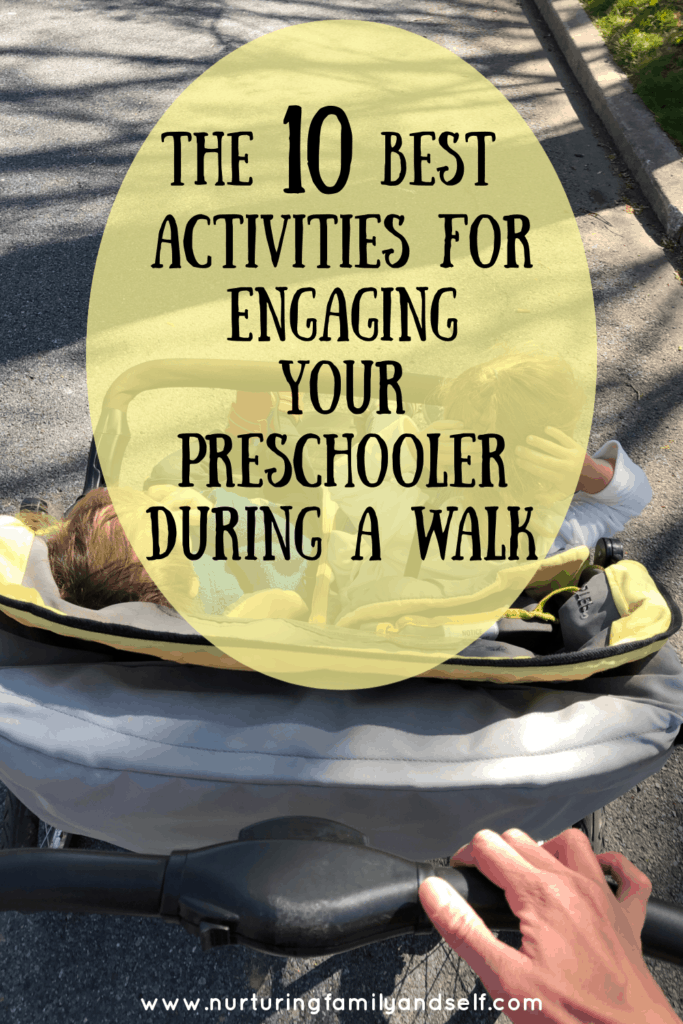
There are many fun ways I keep my 4 ½ year old engaged during our walks so it is enjoyable for everyone. This post is going to share with you 10 of our favorite ways to engage my toddler and preschooler during a 30-45 minute walk.
Plan to leave for a walk at snack time.
We always leave for a walk around 10:15-10:30, which is snacktime in our house. This is usually when I’ve finished doing our at-home preschool learning. My kids are starting to get restless and are ready for a break from the inside of our house.
My little ones happily munch away on their snack for the first 15 minutes of our walk. All hands and mouths are occupied. In fact, I even save special snacks for our walks! These are snacks we only eat when going on walks or family bike rides. Sometimes I bring two snacks and use one as an incentive for positive behavior towards the end of our walk.
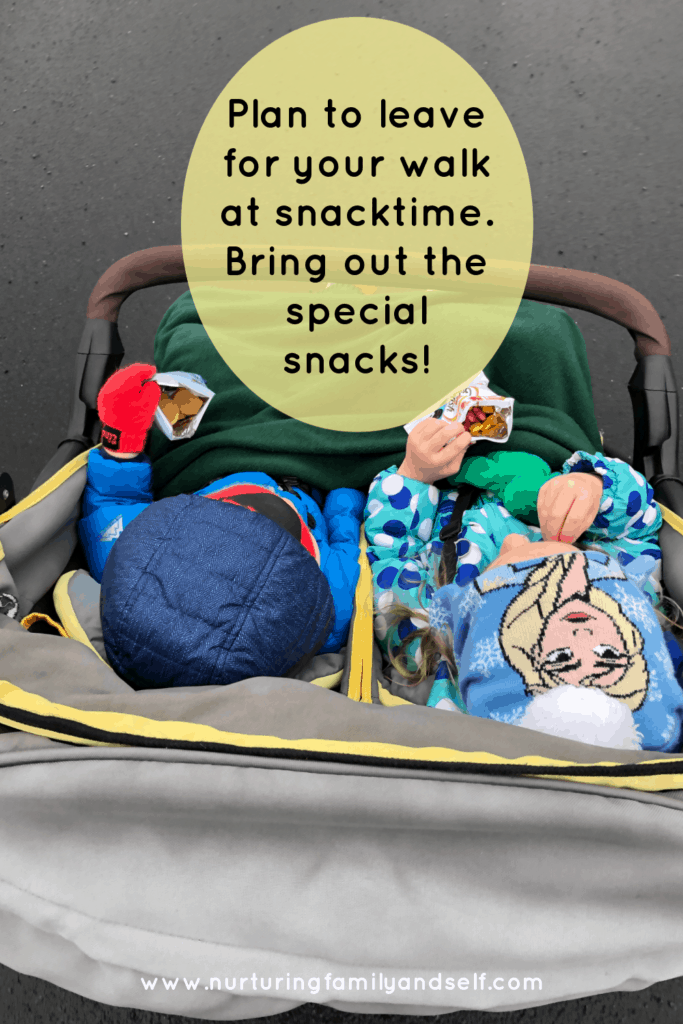
Tell your little ones what will happen after the walk.
Some days we stop at a playground on our walk. Other days we play in our backyard or draw with sidewalk chalk on the driveway after our walk.
I usually say, “If we listen to mommy and keep our hands and feet to ourselves during our walk, we will stop at the playground or draw with sidewalk chalk.”
Some days I give my daughter a choice of which activity she wants to do when we get home. I remind her that we are doing this activity after our walk. This gives her something to look forward to and encourages positive behavior for the duration of the walk.
Sing Nursery Rhymes and Songs
Singing nursery rhymes and songs is fun and a great way to build oral language skills and vocabulary.
One of our favorite nursery rhymes to sing is “Old MacDonald Had A Farm”. My kids take turns choosing the animal on the farm.
“Wheels On the Bus” and “Five Little Speckled Frogs” are other favorite nursery rhyme songs we sing. Another good song to sing is the ABC song!
I am not the best singer and admit I don’t know the words to every nursery rhyme. So having my kids listen to nursery rhymes and sing-along toddler tunes is an option during our walks.
I love Amazon Music because there are 2 million hand-curated songs included with my Amazon Prime membership.
I create playlists within the app of our favorite songs so they are easy to play on the go. With Amazon Music Unlimited, I get unlimited access to over 70 million songs and am able to listen offline, which makes it perfect for our walks. I download the nursery rhymes and songs onto my phone and I’m ready to hit play on our walk.
Super Simple Songs is my favorite collection of kids songs! We enjoy singing to our favorite Disney songs, too! Frozen anyone?! Click the image below to learn more about how you can grab unlimited songs to listen to on your next walk together.
Play Phonological Awareness and Phonemic Awareness Games
Phonological awareness is the ability to hear and manipulate the units of sound in spoken words. Phonemic awareness is the ability to hear and manipulate the smallest unit of sound, a phoneme. For example, counting the number of syllables in a word would be a phonological awareness activity. Counting the number of sounds in a word would be a phonemic awareness activity.
Phonological awareness and phonemic awareness games are 100% auditory, which makes them perfect for playing on the go. They help our little ones strengthen their literacy skills, too! Phonological awareness is one of the strongest predictors of your child’s reading success. Your child needs to be able to hear, blend, and segment the sounds in words in order to read and write words. You can learn more about phonological awareness and phonemic awareness in this article from A Teachable Teacher.
There are many phonological awareness and phonemic awareness games I’ve played with my preschooler. These games are quick and last as long as my daughter is interested. Once she shows disinterest in one, I move onto another one. I love sneaking in some learning on our walks!
Say a sentence and have her identify the number of words in the sentence.
The sentences can be about things you see on your walk or about a specific topic/theme. Silly sentences are always a hit with my 4 ½ year old, too! For example, “There are purple flowers in the yard.” My daughter would repeat the sentence, putting up a finger for each word in the sentence. You can start with shorter 3-4 word sentences and build up as your child successfully identifies the number of words.
Say a word and then follow with rhyming words.
My daughter loves playing rhyming games! For example, I would say “cat” and she would start listing as many rhyming words as she can. Sometimes the words are not real words, what we call nonsense words, but that’s okay because it is still practicing the skill of rhyming and understanding that by manipulating the first sound of a word, we create a rhyming word.
Say a word and have her identify the number of sounds.
This game is a phonemic awareness game because it involves the smallest unit of sound in a word, the phoneme. I say “cat” and my daughter would use her fingers to identify and count the sounds in this word, which would be three: /c/ /a/ /t/.
Clap and count the syllables in a word.
This is a phonological awareness game because it focuses on a bigger unit of sound, syllables. I say “rainbow” and my daughter claps and counts the number of syllables. This game will take some practice! Sometimes I have my daughter put her hand under her chin to count the syllables. Each time her chin drops is a syllable.
Scavenger Hunts
We love scavenger hunts on our walks! We enjoy engaging in these during specific seasons because we can look for house decorations.
I print off a sheet that contains pictures and words of the things we are going to look for. Then I attach it to a clipboard. My daughter marks each picture we find with an “X” or a sticker.
Seasonal scavenger hunts can focus on the features of each season. Fall brings leaves changing color, leaf piles and acorns. Have your child look for bare trees as more and more leaves fall to the ground. Spring brings colorful flowers, bunnies, butterflies, flower buds, and birds singing.
You can grab a copy of my free Springtime Scavenger Hunt by clicking the image below. This scavenger hunt focuses your child’s attention on the features of spring. Plus, you’ll get access to my entire resource library of 20+ beautiful printables that will make your life easier and engage your little ones at home. New printables are being continually added each month and they are all free!
We’ve done the same thing with colors too! As soon as we find something of a specific color, we put an “X” or a sticker on that part of the recording sheet. You can make a simple recording sheet by folding a piece of paper into 8 sections. Take a crayon or marker and write a color word in each section. Write “red” in a red marker, “orange” in an orange marker, etc.
Count things you see along the route.
We count cars that drive by, parked cars, and flags. We count birdhouses and wreaths on front doors. We count birds, squirrels and mailboxes. We’ve also counted seasonal decorations like pumpkins in the fall, snowmen in the winter, hearts on Valentine’s Day and Easter eggs in the spring.
Sometimes I’ve given my daughter a recording sheet, like the scavenger hunts, and we use a tally mark to record the number of times we see something. This worked really well for our fall walks. When we finished our walk, we counted our tally marks and talked about which thing we found the most and least.
When it isn’t a specific holiday or season, we count colors using tally marks. This activity was a fun game during our colors of the rainbow at-home preschool theme. The recording sheet for the color hunt is one of the many hands-on activities we did as part of our Colors of the Rainbow Literacy and Math Early Learning Activity Pack. As we found something in each color, my daughter put a tally mark on that part of the recording sheet. Then we count up the tally marks at the end of our walk and talk about which color we saw the most and which color we saw the least.
Play I Spy
I Spy is a fun game and we do this a lot on our walks and while riding in the car. You can look for things of a specific color or shape. I spy something yellow. I spy a circle. I spy the letter T. The possibilities are endless with this game, which makes it a great one for our walks! My two-year-old enjoys this game, too.
Beginning Letter Sounds
Find things that start with specific letters of the alphabet. During our at-home preschool learning, we focused on a few letters at a time. During our walk, we would look for that letter on road signs or find things that started with that letter. Going on alphabet walks, as we called them, was a wonderful way to extend our learning!
Bring interactive books to read.
A few of the walks we went on, my kids chose their favorite sound books to bring along. But any books are great to bring along for part of your walk. It gives my kids something to hold in addition to engaging them for at least a short amount of time. And you can sneak in some reading time!
We love our sound books and keep many of them in the car for entertaining our little ones during drives. This is our favorite collection of sound books. My kids love finding the buttons to push on each page and hearing the realistic sounds. Plus, the thicker pages make for a more durable book.
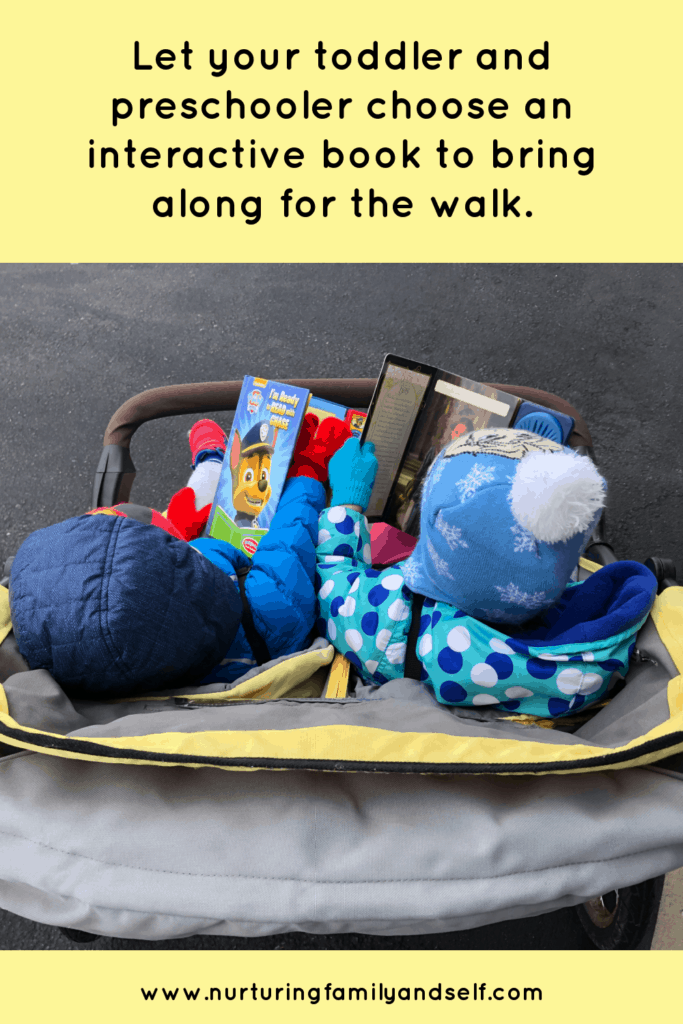
Talk about the signs you see and what they mean.
As you see signs on your walk, ask your child to tell you what the sign means. This can be street signs, stop signs, warning signs, etc. This game not only helps your child develop critical thinking, but it teaches them about the world around him/her.
Ask your child to identify the letters and/or numbers they see on the signs.
We’ve had many conversations about the signs we see. We’ve talked about the purpose of election signs, advertisement signs for contractors and other businesses and congratulations signs for graduations and school sporting events. There have been a lot of these throughout the neighborhoods in which we walk.
Play a Five Senses Game
This is a fun way to talk about your five senses with your preschooler. While you are walking, ask your child to identify something he/she sees, tastes, touches, hears and smells. When I’ve done this game with my daughter, I’ve given her a number of things to identify for each sense. Some of the senses can be hard to come up with, but it does help build critical thinking skills. For example, I see a red bird. I taste my goldfish cracker. I touch the snack bag or stroller. I hear birds singing. I smell fresh cut grass. I usually have to go through the five senses to model how to do it, but it leads to some great conversations. This game is another way to bring your child’s attention to the world around him/her.
Conclusion
The 10 activities described in this post have been lifesavers for me during our daily walks. Each one of these activities engages my preschooler in a way that makes our walks enjoyable for everyone. It is a bonus that most, if not all, of the activities and games sneak in some learning. I want to make the most of every moment I have with my son and daughter 😊
